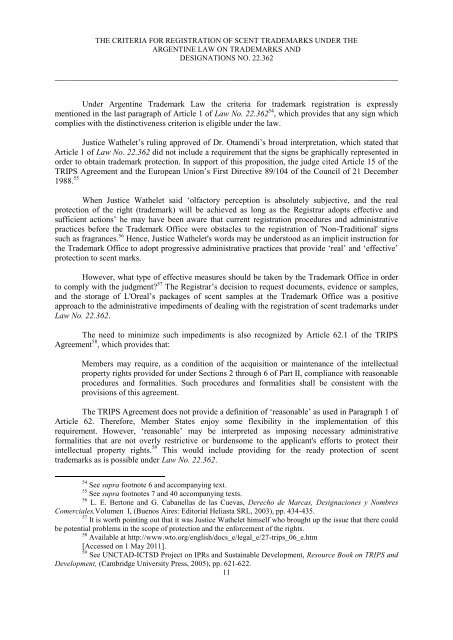WIPO-WTO COLLOQUIUM PAPERS
WIPO-WTO COLLOQUIUM PAPERS
WIPO-WTO COLLOQUIUM PAPERS
You also want an ePaper? Increase the reach of your titles
YUMPU automatically turns print PDFs into web optimized ePapers that Google loves.
THE CRITERIA FOR REGISTRATION OF SCENT TRADEMARKS UNDER THE<br />
ARGENTINE LAW ON TRADEMARKS AND<br />
DESIGNATIONS NO. 22.362<br />
__________________________________________________________________________________<br />
Under Argentine Trademark Law the criteria for trademark registration is expressly<br />
mentioned in the last paragraph of Article 1 of Law No. 22.362 54 , which provides that any sign which<br />
complies with the distinctiveness criterion is eligible under the law.<br />
Justice Wathelet‟s ruling approved of Dr. Otamendi‟s broad interpretation, which stated that<br />
Article 1 of Law No. 22.362 did not include a requirement that the signs be graphically represented in<br />
order to obtain trademark protection. In support of this proposition, the judge cited Article 15 of the<br />
TRIPS Agreement and the European Union‟s First Directive 89/104 of the Council of 21 December<br />
1988. 55<br />
When Justice Wathelet said „olfactory perception is absolutely subjective, and the real<br />
protection of the right (trademark) will be achieved as long as the Registrar adopts effective and<br />
sufficient actions‟ he may have been aware that current registration procedures and administrative<br />
practices before the Trademark Office were obstacles to the registration of 'Non-Traditional' signs<br />
such as fragrances. 56 Hence, Justice Wathelet's words may be understood as an implicit instruction for<br />
the Trademark Office to adopt progressive administrative practices that provide „real‟ and „effective‟<br />
protection to scent marks.<br />
However, what type of effective measures should be taken by the Trademark Office in order<br />
to comply with the judgment? 57 The Registrar‟s decision to request documents, evidence or samples,<br />
and the storage of L'Oreal‟s packages of scent samples at the Trademark Office was a positive<br />
approach to the administrative impediments of dealing with the registration of scent trademarks under<br />
Law No. 22.362.<br />
The need to minimize such impediments is also recognized by Article 62.1 of the TRIPS<br />
Agreement 58 , which provides that:<br />
Members may require, as a condition of the acquisition or maintenance of the intellectual<br />
property rights provided for under Sections 2 through 6 of Part II, compliance with reasonable<br />
procedures and formalities. Such procedures and formalities shall be consistent with the<br />
provisions of this agreement.<br />
The TRIPS Agreement does not provide a definition of „reasonable‟ as used in Paragraph 1 of<br />
Article 62. Therefore, Member States enjoy some flexibility in the implementation of this<br />
requirement. However, „reasonable‟ may be interpreted as imposing necessary administrative<br />
formalities that are not overly restrictive or burdensome to the applicant's efforts to protect their<br />
intellectual property rights. 59 This would include providing for the ready protection of scent<br />
trademarks as is possible under Law No. 22.362.<br />
54<br />
See supra footnote 6 and accompanying text.<br />
55<br />
See supra footnotes 7 and 40 accompanying texts.<br />
56<br />
L. E. Bertone and G. Cabanellas de las Cuevas, Derecho de Marcas, Designaciones y Nombres<br />
Comerciales,Volumen I, (Buenos Aires: Editorial Heliasta SRL, 2003), pp. 434-435.<br />
57<br />
It is worth pointing out that it was Justice Wathelet himself who brought up the issue that there could<br />
be potential problems in the scope of protection and the enforcement of the rights.<br />
58<br />
Available at http://www.wto.org/english/docs_e/legal_e/27-trips_06_e.htm<br />
[Accessed on 1 May 2011].<br />
59<br />
See UNCTAD-ICTSD Project on IPRs and Sustainable Development, Resource Book on TRIPS and<br />
Development, (Cambridge University Press, 2005), pp. 621-622.<br />
11

















